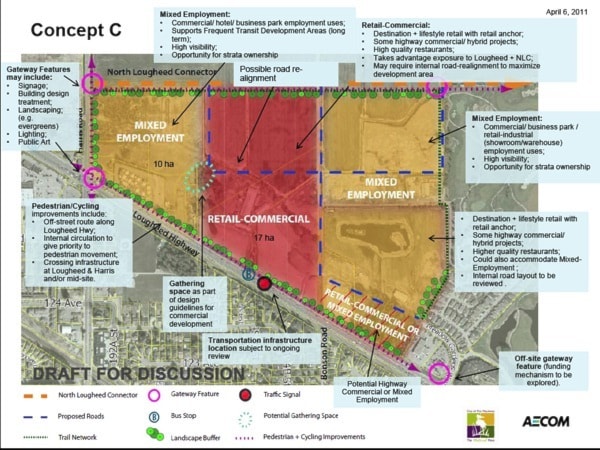To build a road through farmland to draw traffic off another, Pitt Meadows would have to pave over all the green space along an undeveloped commercial strip to its north.
That’s the verdict of consultants hired by the city to review the North Lougheed Corridor, which is proposed to run along the highway from Harris Road to the Meadows Gardens Golf Course.
“That’s pretty much what we’ve concluded,” said David Bell, a senior associate of planning and retail consulting at Colliers International.
With a price tag of $10 million, excluding the cost of land acquisition, the proposed 3.6-kilometre North Lougheed Connector is a thoroughfare the city doesn’t have the cash to pay for.
Add on the costs of building an interchange at Harris Road and Lougheed Highway and the bill spikes to $31 million.
Of the three options sketched out by consultants hired by the city for $40,000, the ones that set aside land for agriculture won’t generate enough cash to cover the costs of building the road.
Even the third option, which proposes a mix of uses, including big stores, a hotel or conference centre, showrooms or a business park on the entire 50.9 hectares (125 acres) site, will struggle to meet the costs.
The AECOM study estimates build-out for the entire site could take between 10 or 12 years.
Bell, however, believes that the third option “can be made to work and achieve the infrastructure improvements that the city is after.”
The city still maintains the connector is being proposed as a way to take traffic off Old Dewdney Trunk Road.
But the road is essential to service the commercial strip, west of Meadow Gardens Way as the province has refused to allow the city to create an access point along busy Lougheed Hwy.
Of the land being considered for development, only 17.5 hectares (43 acres) is zoned highway commercial. The remaining 32.5 hectares (80 acres) would have to be removed from the agricultural land reserve.
Residents who attended an open house on the study overwhelmingly supported the first option, option A, which sets aside 16 hectares (39.5 acres) for farming or other agricultural uses, like a land trust or food processing facility.
The second plan, option B, sets aside 12 hectares (30 acres) for farming.
Coun. Deb Walter, who will be seeking the mayor’s seat this November, is leaning towards supporting development of the entire 50.9 hectares.
“The city has always been saying that this is our line in the sand,” said Walters.
“Quite frankly, I don’t like it, but [the proposed road] is being driven by our farmers. We have to come up with a solution.”
Coun Doug Bing, who will also vie for the mayor’s position this year, believes it makes sense to put development along Lougheed Highway.
“This is the last land that could be developed in Pitt Meadows,” said Bing.
“If we are thinking long-term, this needs to be developed and should be developed. It would have been nice if option B was viable because it would at least preserve some agricultural land, but I have no problem going with option C – if that’s the only way to pay for the road.”
The Agricultural Land Commission approved the proposed road last July, with a caveat that requires the city to get covenants for each of the properties that will be adjacent to it. Those covenants would require each property to remain farmland.
For Coun. Bruce Bell, who is firmly against punching the road through farmland, the consultants’ preliminary findings show the city’s push for the North Lougheed Connector is premature.
“In my view, it’s before its time. The North Lougheed Connector doesn’t appear to be sustainable,” said Bell.
“Even the consultant said this is some of the best land in Pitt Meadows for farming. It’s a shame, it should be farmed.”
Council has yet to received the final report from AECOM. It is expected to be completed by mid-June.
